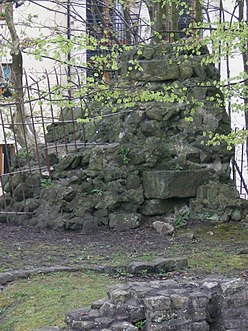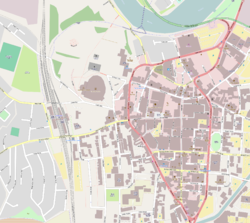| Lancaster Roman Fort | |
|---|---|
 Surviving ruins of the third fort (Wery Wall) | |
| Founded during the reign of | Vespasian / Titus |
| Founded | c. 80 AD |
| Abandoned | 5th century |
| Place in the Roman world | |
| Province | Britannia |
| Nearby water | River Lune |
| Structure | |
| — Stone structure — | |
| Built during the reign of | Trajan |
| Built | c. 102 AD |
| — Wood and earth structure — | |
| Built during the reign of | Vespasian / Titus |
| Built | c. 80 AD |
| Stationed military units | |
| — Cohorts — | |
| ala Augusta, ala Sebosiana, numerus Barcariorum Tigrisiensium | |
| Location | |
| Coordinates | 54°03′05″N 2°48′12″W / 54.05150°N 2.80347°W |
| Town | Lancaster |
| County | Lancashire |
| Country | England |
| Reference | |
| UK-OSNG reference | SN643564 |
| Site notes | |
| Discovery year | 1950 |
| Condition | Earthworks and ruins |
| Controlled by | Scheduled Monument (SAM: CD129) |
Lancaster Roman Fort, also known as Wery Wall, Galacum or Calunium,[citation needed] is the modern name given to ruined former Roman fort atop Castle Hill in Lancaster in North West England. The first castra was founded c. 80 AD within the Roman province of Britannia.
The fort's name is not known. A Roman milestone found four miles outside Lancaster, with an inscription ending L MP IIII, meaning "from L— 4 miles", suggests that it began with that letter.[1] However in 1998 David Shotter suggested that Galacum, a name that has been associated with the fort at Over Burrow, would be more appropriately applied to Lancaster.[2]
The fort is thought to be the origin of the name Lancaster. It appears in the Domesday Book as Loncastre, where "Lon" refers to the River Lune, with the Old English cæster (borrowed from the Latin castrum) for "fort".[3]
- ^ Rivet & Smith 1979, p. 382.
- ^ Shotter 1998, p. 10.
- ^ Ekwall 1960, p. 285.

